You’re about to discover seven innovative ways to transform your living spaces with carefully curated plant arrangements. From creating dramatic living walls that command attention to designing multi-level displays that maximize vertical space, these decor ideas will help you bring the outdoors in. Whether you’re working with a sunny window ledge or a blank wall canvas, you’ll find practical solutions that match your style while nurturing your growing collection of botanical beauties.
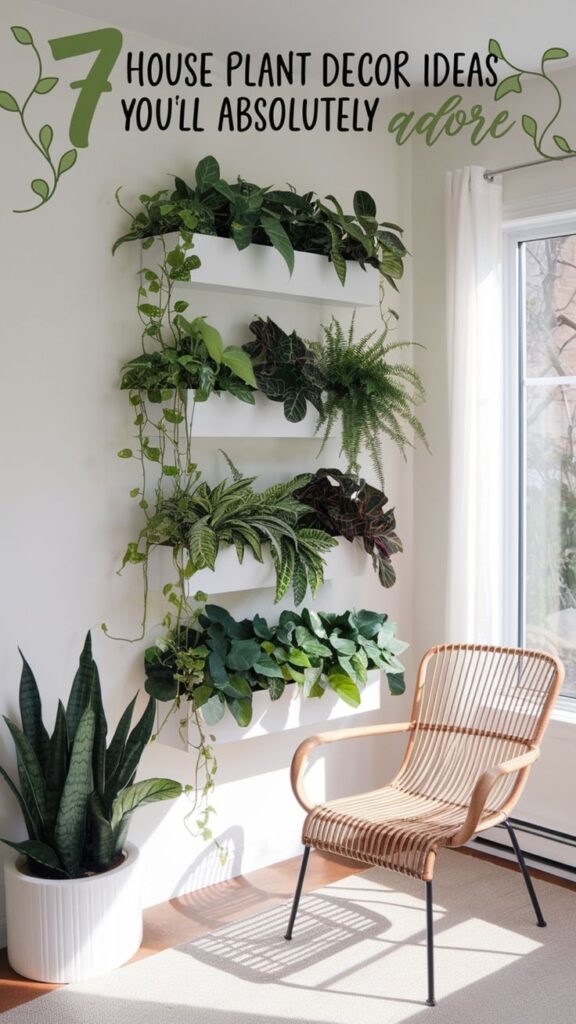
Contents
- 1 Create a Living Wall With Vertical Plant Displays
- 2 Style Picture-Perfect Plant Shelving Arrangements
- 3 Embrace Macramé and Hanging Plant Gardens
- 4 Design Statement Plant Corners With Mixed Heights
- 5 Transform Windows Into Greenhouse Spaces
- 6 Showcase Plants in Unique Vintage Containers
- 7 Build a Multi-Level Plant Stand Showcase
Create a Living Wall With Vertical Plant Displays
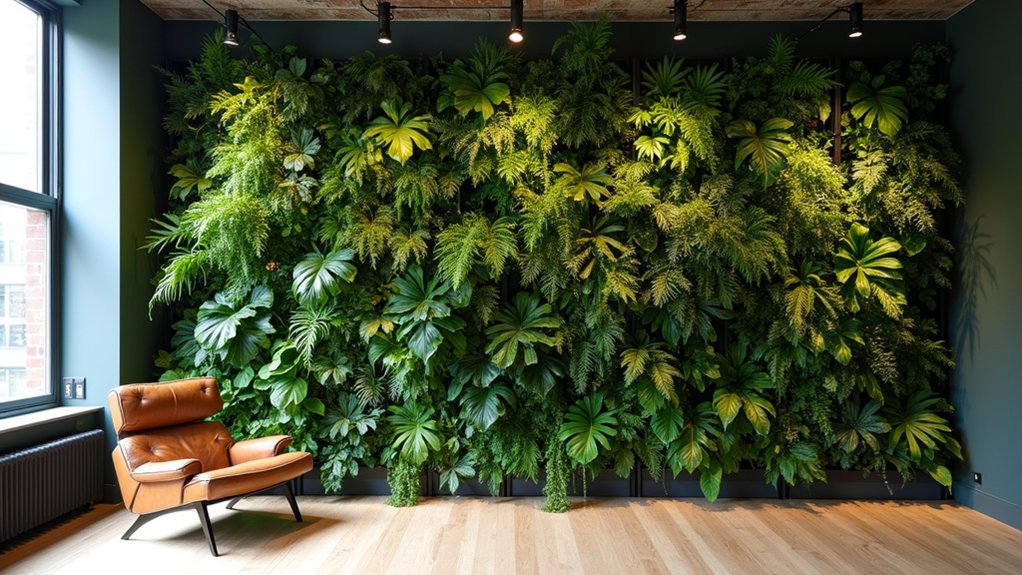
Living walls transform ordinary vertical spaces into lush, eye-catching gardens by arranging multiple plants in mounted containers, pocket planters, or modular systems.
These dramatic displays can cover entire walls or create smaller focal points, combining different textures, colors, and plant varieties to achieve a tapestry-like effect. Vertical gardens maximize space efficiency while providing natural insulation and improved air quality.
Growing Conditions:
- Light: Varies by plant selection; most indoor living walls thrive in bright, indirect light
- Water: Consistent moisture with good drainage; may require drip irrigation systems
- Soil: Lightweight, well-draining potting mix suitable for each plant type
- Humidity: 40-60% relative humidity
- Temperature: 65-80°F (18-27°C)
- Air circulation: Moderate airflow to prevent mold and fungal growth
Regular maintenance ensures a thriving living wall display.
Inspect plants weekly for signs of stress or disease, trim dead foliage, and rotate plants if needed to ensure even growth.
Check irrigation systems and mounting hardware monthly for proper function.
Every 3-6 months, assess plant health, replace struggling specimens, and fertilize according to each species’ needs.
Dust leaves periodically to maintain photosynthesis efficiency and aesthetic appeal.
Style Picture-Perfect Plant Shelving Arrangements
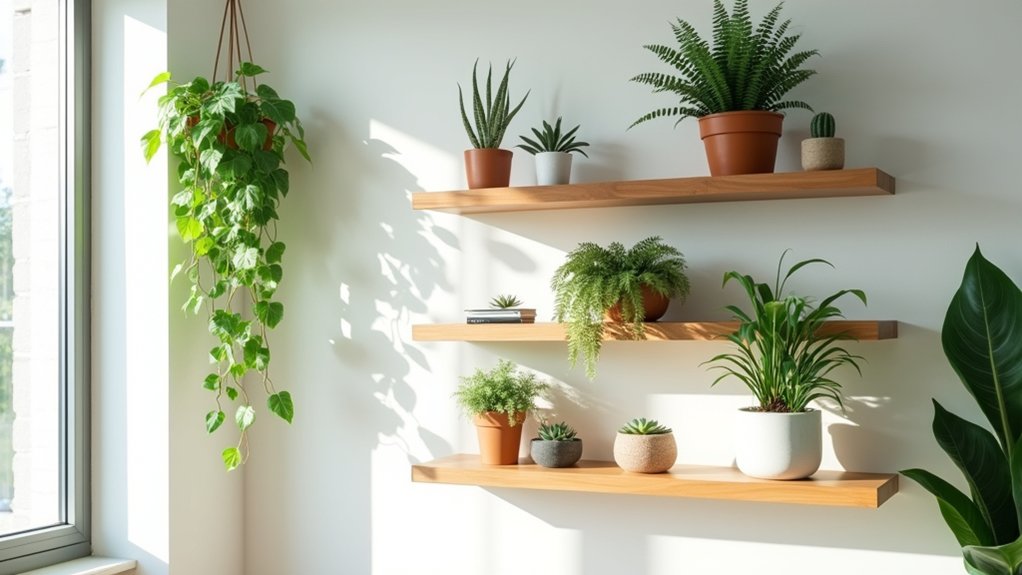
Creating picture-perfect plant shelving arrangements transforms ordinary walls into living galleries through thoughtfully curated displays of houseplants. These arrangements typically feature shelves mounted at varying heights and depths, showcasing plants of different sizes, textures, and growing habits. The most visually appealing setups incorporate a mix of trailing plants that cascade downward, upright specimens that add height, and compact plants that fill middle spaces, creating a dynamic multi-layered effect.
For optimal plant shelf arrangements:
- Light: Position shelves near windows receiving bright, indirect light; east or west-facing windows are ideal
- Distance: Keep shelves 2-3 feet from windows to prevent leaf burn
- Weight capacity: Ensure shelves can support fully watered plants and their containers
- Spacing: Allow 12-18 inches between shelves for plant growth
- Ventilation: Maintain good air circulation between plants to prevent fungal issues
Regular maintenance ensures shelving displays remain attractive and healthy. Rotate plants quarterly to promote even growth and prevent plants from permanently leaning toward light sources.
Dust leaves monthly with a damp cloth to maintain photosynthesis efficiency and aesthetic appeal. Inspect plants weekly for signs of pest infestation or disease, which can spread quickly in grouped arrangements.
Prune regularly to maintain desired shapes and remove any yellowing or dead foliage that could detract from the overall display.
Embrace Macramé and Hanging Plant Gardens
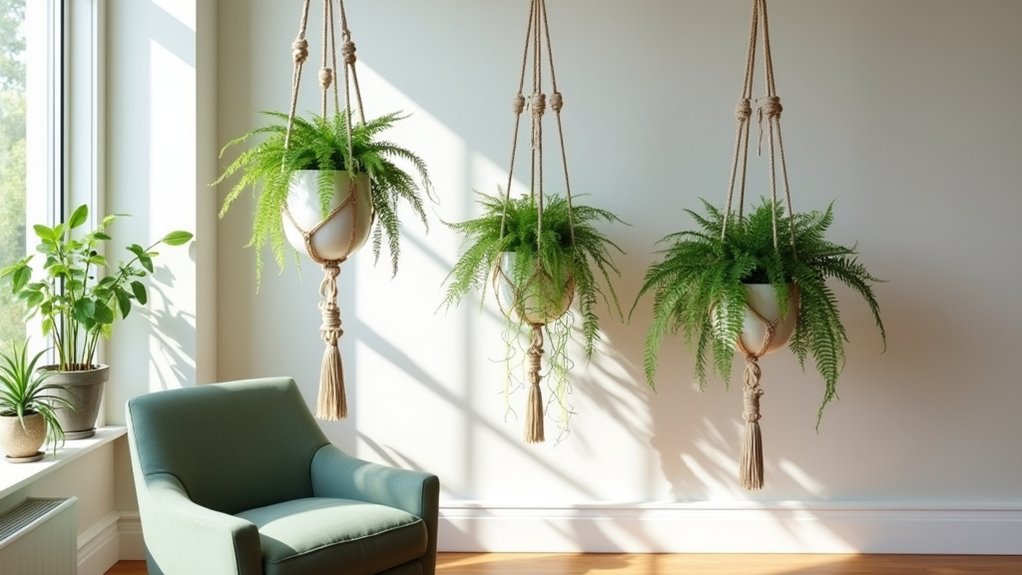
Macramé and hanging plant gardens bring a bohemian, artistic element to interior spaces while maximizing vertical growing opportunities. These suspended gardens typically feature intricate hand-knotted rope holders supporting various trailing plants, creating dynamic layers of greenery that cascade from ceiling to floor.
The combination of natural fibers and living plants adds texture and visual interest while freeing up valuable floor and shelf space.
- Light: Most hanging plants prefer bright, indirect light; avoid harsh direct sunlight that can damage delicate leaves
- Water: Water needs vary by plant species; ensure proper drainage to prevent root rot
- Soil: Well-draining potting mix with good aeration
- Container: Use lightweight pots with drainage holes, sized appropriately for plant variety
- Height: Install at a height that allows for plant growth while remaining accessible for care
- Support: Secure hanging hardware into ceiling joists or use strong wall anchors rated for weight
Regular maintenance of macramé and hanging gardens requires special attention to prevent common issues unique to suspended plantings.
Check knots and hanging hardware monthly for signs of wear or loosening, especially in humid conditions that can affect rope integrity.
Rotate plants quarterly to ensure even growth, and trim trailing vines to maintain desired length and prevent tangling.
When watering, either remove plants to water thoroughly and drain, or use a targeted watering tool to prevent overflow and damage to the macramé or surfaces below.
Design Statement Plant Corners With Mixed Heights
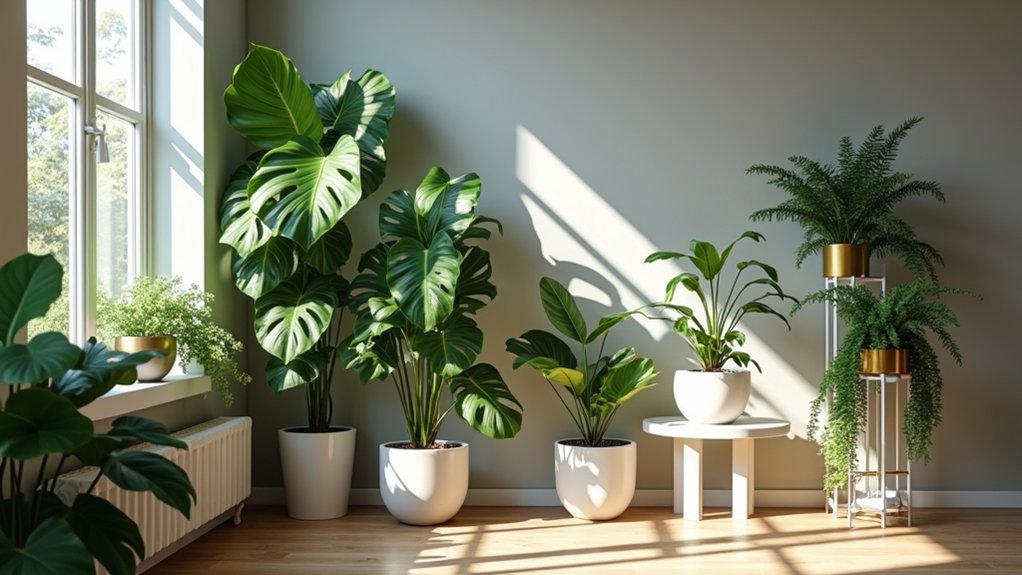
Creating a design statement plant corner involves strategically arranging plants of varying heights to produce a visually dynamic and layered display. Tall floor plants like fiddle leaf figs or bird of paradise serve as anchors, while medium-sized plants on stands or shelves fill the middle ground, and trailing plants like pothos or string of pearls cascade downward.
This multi-level approach adds depth and interest to empty corners, transforming them into lush, living focal points that draw the eye naturally through the space.
Growing conditions for a mixed-height plant corner:
- Light: Choose a corner with consistent indirect light, ideally near a window
- Temperature: Maintain 65-80°F (18-27°C) for most tropical houseplants
- Humidity: Group plants together to create a microclimate of 40-60% humidity
- Space: Allow 1-2 feet between larger plants for adequate air circulation
- Support: Provide sturdy shelving, plant stands, or wall-mounted options that can handle pot weight
To maintain a thriving plant corner, rotate plants quarterly to ensure even growth and prevent leaning toward light sources. Dust leaves monthly with a damp cloth to maximize photosynthesis and maintain aesthetic appeal.
Monitor the varying watering needs of different plant species, as taller plants typically require more water than smaller ones. Group plants with similar care requirements together to streamline maintenance, and regularly inspect for signs of pests or disease that can spread quickly in densely planted areas.
Transform Windows Into Greenhouse Spaces
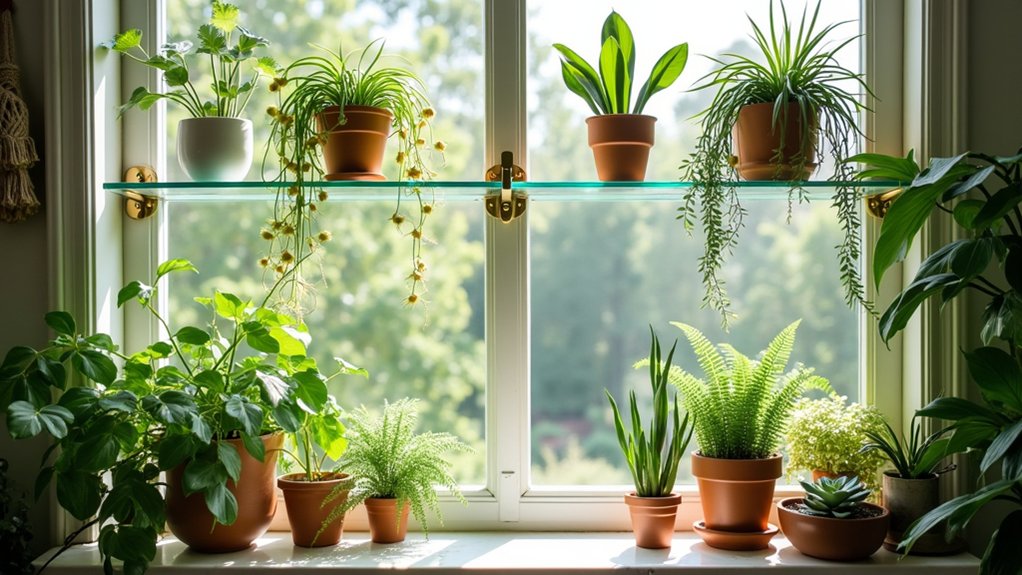
Windows can become stunning indoor greenhouse spaces by strategically arranging plants on shelves, hanging planters, and window sills to maximize natural light exposure. This transformation creates a lush, living display that brings the outdoors in while making efficient use of vertical space.
Glass shelving, decorative brackets, and tiered plant stands allow for multiple layers of greenery, while ensuring all plants receive adequate light penetration.
- Light: Bright, indirect sunlight for most indoor plants; protect delicate specimens from harsh afternoon sun
- Temperature: 65-80°F (18-27°C), away from cold drafts and heating vents
- Humidity: 40-60% relative humidity; group plants together or use humidity trays
- Air Flow: Gentle circulation without direct drafts
- Space: Allow 2-3 inches between plants for proper air circulation
- Support: Sturdy mounting systems rated for weight of plants, pots, and water
Regular maintenance of window greenhouse spaces requires weekly dusting of leaves to maximize light absorption, rotating plants quarter-turns for even growth, and inspecting for signs of pest infestation or disease.
Seasonal adjustments include moving sensitive plants further from windows during extreme temperatures, cleaning glass surfaces monthly to ensure optimal light transmission, and reassessing plant placement as natural light patterns change throughout the year.
Showcase Plants in Unique Vintage Containers
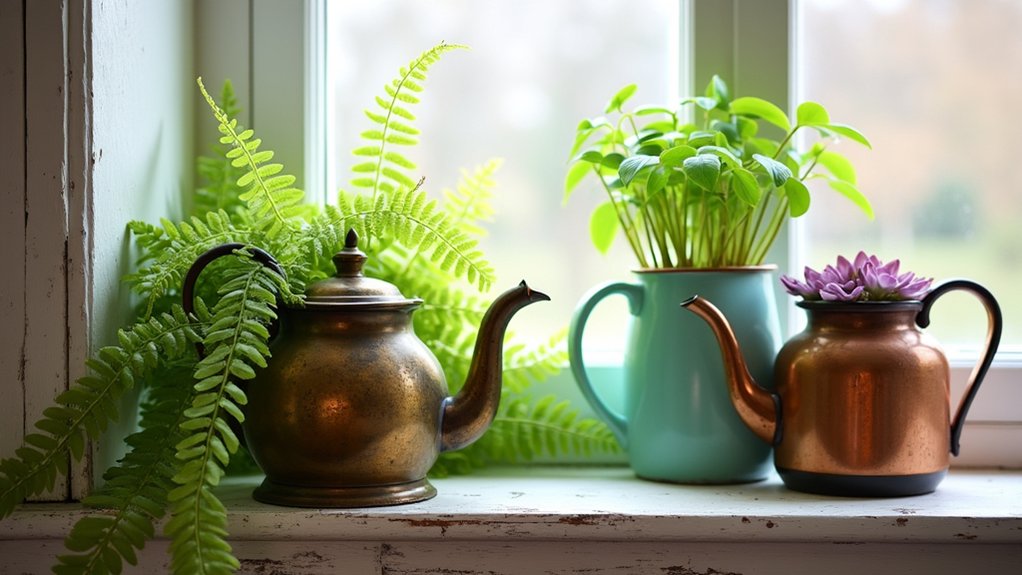
Vintage containers add character and charm to houseplant displays while promoting sustainability through creative reuse. Old teapots, antique brass vessels, weathered wooden crates, and retro ceramic pieces can transform ordinary plants into stunning decorative statements.
These unique containers create visual interest through their patina, intricate designs, and historical appeal, while providing an eclectic backdrop that complements the natural beauty of plants. When selecting vintage containers, ensure they’ve proper drainage or use them as cache pots with well-draining inner containers.
Growing Conditions:
- Choose containers with adequate drainage holes or drill holes if needed
- Select container size appropriate for plant root system
- Line metal containers with plastic to prevent mineral leaching
- Place cork or rubber feet under containers to protect furniture
- Use well-draining potting mix suitable for specific plant species
- Position containers to match plant light requirements
- Consider container weight when placing on shelves or hanging
Maintaining plants in vintage containers requires regular monitoring of moisture levels since antique vessels may lack modern drainage features.
Inspect containers periodically for signs of deterioration, rust, or damage that could affect plant health. Clean containers gently with appropriate materials to preserve their finish while preventing buildup of mineral deposits or mold.
Consider applying clear sealant to porous materials like unglazed ceramics or wood to prevent water damage while preserving the container’s authentic appearance.
Build a Multi-Level Plant Stand Showcase
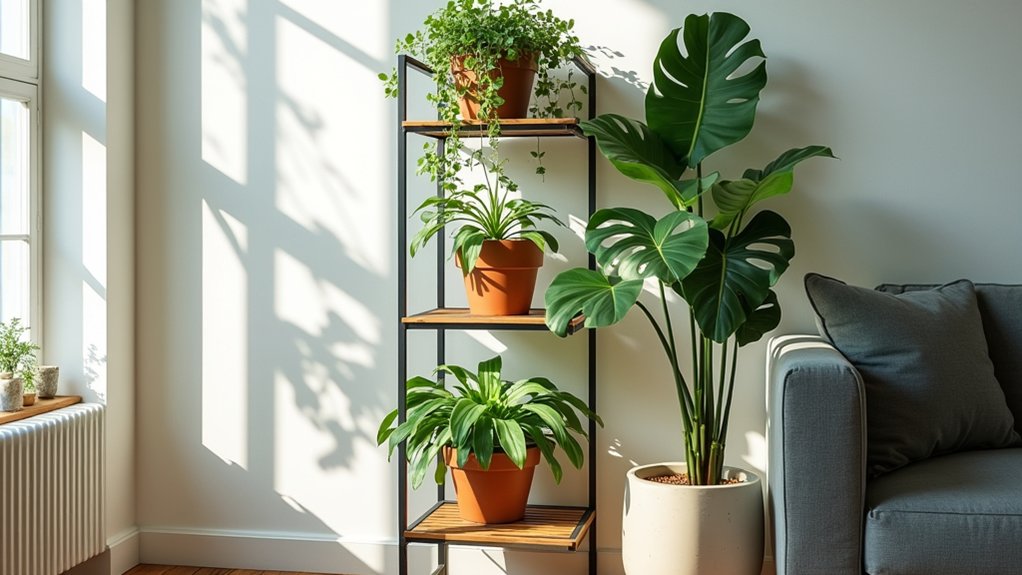
A multi-level plant stand showcase creates a striking visual display that maximizes vertical space while accommodating plants of varying sizes and light requirements.
These decorative structures typically feature multiple tiers or platforms arranged in a stepped or cascading formation, allowing smaller plants to sit higher up while larger specimens occupy lower levels. The design can range from minimalist metal or wooden frames to elaborate architectural pieces that serve as both functional plant storage and artistic home decor.
- Position stand near east or west-facing windows for optimal natural light distribution
- Ensure each tier receives appropriate light based on individual plant needs
- Leave adequate space between levels for plant growth and maintenance
- Choose sturdy materials that can support pot weight and moisture
- Include drainage solutions or trays for each level
- Consider humidity levels around the entire structure
Regular maintenance of a multi-level plant stand involves strategic rotation of plants to ensure even growth and prevent leaning toward light sources.
Dust both the structure and plant leaves periodically to maintain aesthetics and plant health, and inspect the stand’s stability monthly, tightening any loose components.
When watering, work from top to bottom to catch any overflow, and periodically rearrange plants based on their growing patterns and seasonal light changes to maintain an attractive and balanced display.
